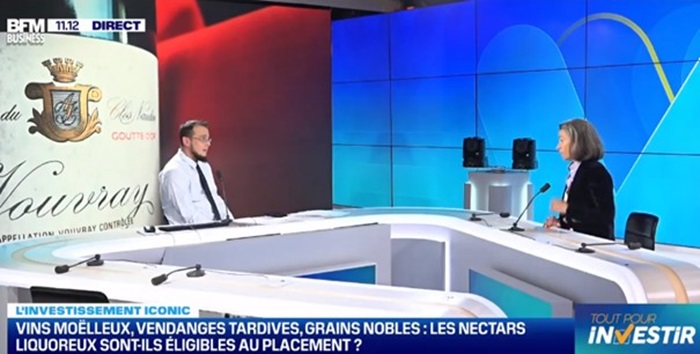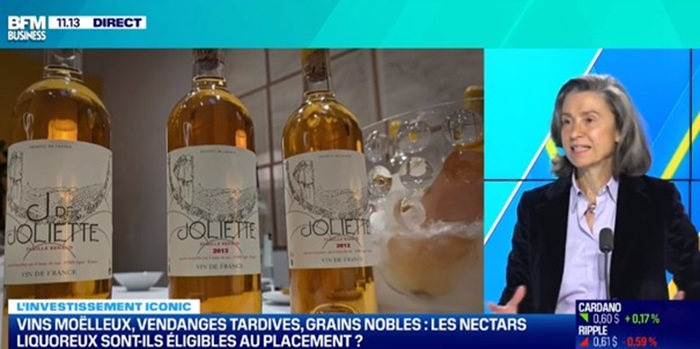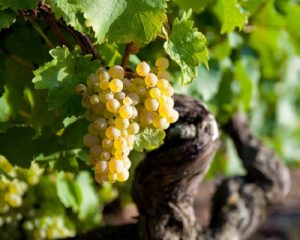
When the end-of-year festivities roll around, many of us seek out sweet wines. But do these types of wines offer investment possibilities? Angélique de Lencquesaing, one of the co-founders of iDealwine, was recently interviewed by the French television channel BFM during its programme “All for investment” with Antoine Larigaudrie.
Antoine Larigaudrie: First things first, why are some wines sweet?
Sweet wines get their sugar from the grapes that make them rather than from added sugar (which is only added under specific circumstances such as the 2021 vintage in Gironde.
During fermentation, the sugar in the berries is transformed into alcohol by the yeast. Residual sugar in the wine comes from a fermentation process that did not convert all the sugar. High amounts of sugar come from sunny vintages when the grapes are extremely ripe before harvest or when the berries have been affected by noble rot.
Where are sweet wines produced in France? There’s Sauternes but where else?
There are several regions in France where you can find sweet wine production: Sauternes and its neighbour Barsac in Bordeaux, Alsace with its late harvest wines (vendanges tardives) and sélections de grains nobles (wines made from grapes affected by noble rot), as well as other appellations dedicated to sweet wine like AOC Quarts de Chaume in the Loire Valley. There’s also brilliant sweet wines produced in the South-West (Jurançon, Monbazillac), in the southern Rhône Valley (Beaume de Venise) and in Corsica (Muscat du Cap Corse).

You mentioned noble rot which is a requirement of Sauternes production. These wines are known to be difficult to produce…
Yes, this type of sweet wine depends a lot on the weather. It requires the fungus called botrytis cinerea, which causes noble rot, to develop on the grapes and in some years, the weather conditions just aren’t suitable. Or the yield isn’t deemed to be sufficient enough. It’s in these years that the producers in Sauternes and Barsac have to admit defeat and not produce their sweet wines.
This happened a few times for Château d’Yquem during the 20th century and most recently in 2012. There is, therefore, at lot of risk for winemakers when they set out to make sweet wine in this way. We also have to say that other regions, such as the Loire Valley and Alsace, produce wines from noble rot too.
Alsace produces very particular sweet wines…
Alsace boasts a strong regional identity, expressed through its multi-faceted terroirs and, of course, its grape varieties: Riesling, Pinot Gris and Gewurztraminer. The variety of wines it produces is simply fascinating. When it comes to its sweet wines, Vendanges Tardives (wines made from late-harvested grapes) and Sélections de Grains Nobles (wines made from grapes affected by noble rot) spring to mind. They create magical wines with amazing density because the grapes are harvested one berry at a time when they’re extremely ripe. I should add that these wines have remarkable ageing capacities.
These wines seem to struggle to find their market. Why’s that?
The distaste of sugar and sweetness is a phenomenon that has been growing for decades. Sugar is one of the number one enemies for health programmes, which is a bit a paradox when we see the success of certain pastry stars.
Sauternes has long been seen as a dessert wine or a wine to pair with foie gras, but there are many, more interesting pairing possibilities such as poultry, fish, tropical cuisine and blue cheese.
On the secondary, auction market, sweet wines from all regions represented 4% of the volume sold last year. A tiny proportion that remains stable.

It’s quite expensive this type of wine, isn’t it? And Château d’Yquem in particular?
Sauternes, like other sweet wines, is especially difficult to produce as we’ve already seen. The grapes are harvested one at a time during several passes of the rows of vines once they have been sufficiently affected by noble rot. The price of the wine quite often does not match the work that goes into creating it for most producers. Château d’Yquem is the exception. This historical property crafts a wine that has gone down in history. There are also other properties to take note of including Châteaux de Fargue, Climens, Doisy Daëne, and Gilette which all produce eternal wines.
Can Sauternes like Château d’Yquem be considered as wines to invest in?
It depends what your goals are. If you only plan to keep the bottles for a few years before reselling them, sweet wines are not you. Because these wines – which age beautifully thanks to the sugar – age slowly and their value appreciates over the long term. On iDealwine, a 1945 Château d’Yquem sold for €1,289 recently. The important thing is to manage the purchase price well because the ageing process will take decades.
So you could buy Sauternes or other sweet wines at a relatively low price if you are prepared to wait?
Yes, exactly. Wonderful Sauternes are accessible once they’re 30 years old. Despite a smaller production in Alsace, the Vendanges Tardives remain reasonable. And what about the sweet wines from Anjou (Huet, Belargus) or the South-West (Dagueneau, Camin Larredya, Clos Joliette)? These amazing producers also produce exquisite wines that are all eternal. Another type of sweet wine is Vin de Paille (literally straw wine in English), in which the grapes are dried before vinification to extract an even more concentrated juice. It can be found in various regions in the south of France (in Roussillon, at Clos des Fées, in Jura or the Rhône Valley).
You’ve only spoken about France. Are sweet wines only made there?
Not, certainly not. Sweet wines are made in other countries too. Hungary produces sweet wines in Tokaj. Last year, a bottle from there obtained the highest price for a sweet wine seen at iDealwine auctions. A 1889 went under the hammer for €1,474. The second country that comes to mind is South Africa with its historical sweet wine from Klein Constantia produced in the Cap. Indecently, it’s a wine that Napoleon enjoyed. And then there’s the Eiswein or ice wine produced in certain northern countries like Germany or Canada. The grapes that create this wine are harvested very late once they have been frozen which concentrates the flavours and aromas held in the berries. A German Eiswein from Egon Muller was sold on iDealwine for €1,228 for the 1995 vintage.
As always, it’s important to look for wine of the highest quality and rare productions can help too. These magnificent, rich gold wines will always delight enlightened wine enthusiasts.
View all sweet wines currently for sale



